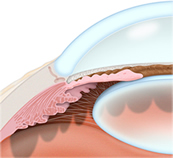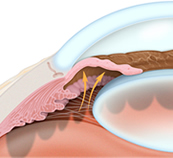GLAUCOMA
Glaucoma is a leading cause of blindness and visual impairment. Glaucoma, known as the “sneak thief of sight,” can affect patients of all ages. Many people affected with glaucoma do not experience any symptoms and may not be aware that they have the disease until they have lost a significant amount of vision.
With early detection and treatment, eyes can be protected against the serious loss of vision or blindness. Glaucoma can affect anyone from newborn infants to the elderly.
TYPES OF GLAUCOMA
There are several types of glaucoma with two main types:
open-angle and angle-closure.
OPEN-ANGLE GLAUCOMA
 Open-angle glaucoma is the most common type of glaucoma where the fluid in the eye drains too slowly through the network of tiny drainage channels, known as the trabecula. The pressure in the eye increases as the fluid in the eye continues to build. Loss of vision occurs gradually and the vision loss is not always noticed until it becomes irreversible. About 95 percent of glaucoma cases are due to open-angle glaucoma.
Open-angle glaucoma is the most common type of glaucoma where the fluid in the eye drains too slowly through the network of tiny drainage channels, known as the trabecula. The pressure in the eye increases as the fluid in the eye continues to build. Loss of vision occurs gradually and the vision loss is not always noticed until it becomes irreversible. About 95 percent of glaucoma cases are due to open-angle glaucoma.ANGLE-CLOSURE GLAUCOMA
 Angle-closure glaucoma occurs when the tiny drainage channels, known as the trabecula, become blocked which then causes a sudden rise in pressure in the eye. This condition is not common but when it occurs it requires immediate medical attention.
Angle-closure glaucoma occurs when the tiny drainage channels, known as the trabecula, become blocked which then causes a sudden rise in pressure in the eye. This condition is not common but when it occurs it requires immediate medical attention.RISK FACTORS FOR GLAUCOMA
Everyone is at risk for developing glaucoma. Those at greater risk meet the following criteria:
- Are at least 45 years old without regular eye exams
- Have a family history of glaucoma
- Have abnormally high eye pressure
- Are of African descent
- Are Hispanic and older than 60
- Are nearsighted
- Have thin corneas
- Have diabetes
- Have a previous eye injury
- Regularly use cortisone/steroid products
DIAGNOSIS OF GLAUCOMA
To detect glaucoma, the physician will perform the following tests:
- Visual acuity
- Visual field
- Tonometry
- Dilated-eye examination
- Retinal evaluation
- Pachymetry
- Gonioscopy
TREATMENT OF GLAUCOMA
Once glaucoma has been diagnosed, treatment should begin as soon as possible to help minimize the risk of permanent vision loss. There is no cure for glaucoma, so treatment focuses on relieving symptoms and preventing further damage. Treatment for each individual case depends on the type and severity of the glaucoma. Some of the treatment methods for glaucoma are:
MEDICATION
Eye drops or oral medication may be used to either reduce fluid production in the front of the eye or to help drain excess fluid. Side effects of the medication may result in redness, stinging, irritation or blurry vision.
LASER SURGERY
Trabeculoplasty, iridotomy or cyclophotocoagulation are laser procedures that aim to increase the outflow of fluid from the eye or eliminate fluid blockages.
SURGERY
A trabeculectomy may be performed to create a new channel to drain fluid from the eye and reduce the pressure that causes glaucoma.















